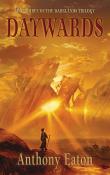 984855102411295430.jpg
984855102411295430.jpg
 984855102411295430.jpg
984855102411295430.jpg
'When you've run from the past, you have to stand and face the future...
'Dara, her brother Jaran and their cousin Eyna have grown up among the Clan; their lives are peaceful as they eke out an existence in the towering forest below their escarpment home. But when the ghosts of a dead civilisation reach out to haunt them one final time, they and their family must set out, on an unmapped path across a dying land.
'Walking daywards, always into the sun.' Source: www.uqp.uq.edu.au (Sighted 07/04/2010).
Drawing upon ideas of practice-led research outlined by Webb and Brien (2008), and considering these within the context of my own creative practice, this article explores the intersections of the positions of writer-as-teacher, writer-as-artist, and writer-as-scholar. This is contextualized with reference to three of my creative works from different phases of my career, A New Kind of Dreaming (2001 ), Fireshadow (2005) and Daywards (2010). Framed by Webb’s argument for the appropriateness of Bourdieu’s ideas of practice-led research (2012) and Nodelman’s suggestions about the relationship between habitus and the agency of young-adult writers (2008), it will examine the degree to which my construction of young protagonists has been shaped by, and has in turn shaped, my changing habitus as a practicing young adult writer and scholar of children’s literature. Drawing upon my dual roles as scholar and teacher of creative writing within the academy, and reader and scholar of children’s literature studies, it argues that the liminality of the scholarly/creative space emerging from this nexus has impacted upon the ways I consider and construct my ‘child’ characters and my own position in relation to them.'
Source: Abstract.
Drawing upon ideas of practice-led research outlined by Webb and Brien (2008), and considering these within the context of my own creative practice, this article explores the intersections of the positions of writer-as-teacher, writer-as-artist, and writer-as-scholar. This is contextualized with reference to three of my creative works from different phases of my career, A New Kind of Dreaming (2001 ), Fireshadow (2005) and Daywards (2010). Framed by Webb’s argument for the appropriateness of Bourdieu’s ideas of practice-led research (2012) and Nodelman’s suggestions about the relationship between habitus and the agency of young-adult writers (2008), it will examine the degree to which my construction of young protagonists has been shaped by, and has in turn shaped, my changing habitus as a practicing young adult writer and scholar of children’s literature. Drawing upon my dual roles as scholar and teacher of creative writing within the academy, and reader and scholar of children’s literature studies, it argues that the liminality of the scholarly/creative space emerging from this nexus has impacted upon the ways I consider and construct my ‘child’ characters and my own position in relation to them.'
Source: Abstract.